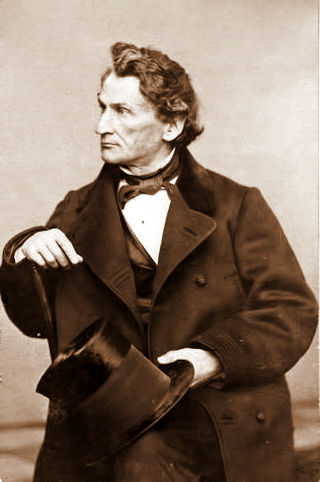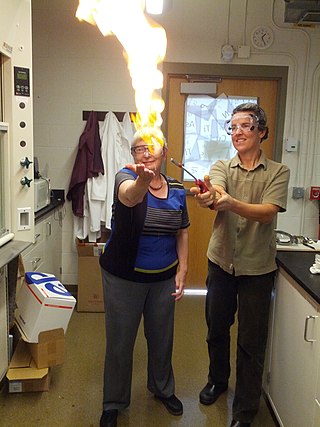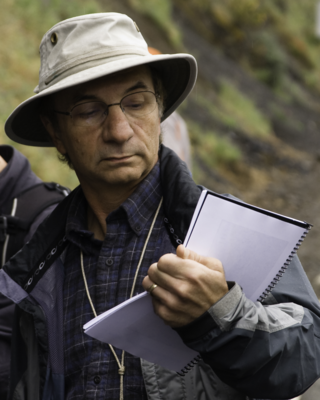Related Research Articles

James Dwight DanaFRS FRSE was an American geologist, mineralogist, volcanologist, and zoologist. He made pioneering studies of mountain-building, volcanic activity, and the origin and structure of continents and oceans around the world.
William Sefton Fyfe, was a New Zealand geologist and Professor Emeritus in the department of Earth Sciences at the University of Western Ontario. He is widely considered among the world's most eminent geochemists.

Erasmus Haworth (1855–1932) was an American geologist.
Robert Edward Folinsbee was a Canadian geologist, whose work involved geochronology, ore deposits, and meteorites.
Anthony James "Tony" Naldrett, FRSC was an English and Canadian geologist. He was an authority on the geology and origin of nickel-copper-platinum group element deposits, the tectonic setting in which they occur, the petrology of associated rocks, and controls on their composition. He was an expert on the reaction between sulfide and silicate melts, fractional crystallization of sulfide melts, and the role of hydrothermal fluids.

Alexandra Navrotsky is a physical chemist in the field of nanogeoscience. She is an elected member of the United States National Academy of Sciences (NAS) and the American Philosophical Society (APS). She was a board member of the Earth Sciences and Resources division of the NAS from 1995 until 2000. In 2005, she was awarded the Urey Medal, by the European Association of Geochemistry. In 2006, she was awarded the Harry H. Hess Medal, by the American Geophysical Union. She is currently the director of NEAT ORU, a primary program in nanogeoscience. She is distinguished professor at University of California, Davis.

Jillian Fiona Banfield is professor at the University of California, Berkeley with appointments in the Earth Science, Ecosystem Science and Materials Science and Engineering departments. She is the director of microbiology the Innovative Genomics Institute, is affiliated with Lawrence Berkeley National Laboratory and has a position at the University of Melbourne, Australia. Some of her most noted work includes publications on the structure and functioning of microbial communities and the nature, properties and reactivity of nanomaterials.
Gediminas Motuza-Matuzevičius is a Lithuanian geologist and author of geology textbooks. He is currently professor in the Faculty of the Natural Sciences at Vilnius University and honorary professor of the Polish Academy of Sciences.
Dr. E-An Zen (任以安) was born in Peking, China, May 31, 1928, and came to the U.S. in 1946. He became a citizen in 1963. Since 1990 he was adjunct professor at the University of Maryland. He died on March 29, 2014, at the age of 85.

Bernard Elgey Leake is an English geologist. He is Emeritus Professor of Geology at the University of Glasgow, was Leverhulme Emeritus Fellow at Cardiff University 2000-2002 and has been an Honorary Research Fellow at Cardiff University since 1997.

Donald James DePaolo is an American professor of geochemistry in the department of earth and planetary science at the University of California, Berkeley and associate laboratory director for energy and environmental sciences at the Lawrence Berkeley National Laboratory.
Robert Andrew Howie was a notable English petrologist.
Margaret Leinen is an American paleoceanographer and paleoclimatologist. In 2013, Leinen was appointed the 11th director of the Scripps Institution of Oceanography, as well as the dean of the School of Marine Sciences at the University of California, San Diego. She founded the Climate Response Fund, a non-profit focused on enabling better understanding, regulation and responsible use of climate engineering research, and served as its president for a time. For two years, Leinen also worked as chief science officer for a startup company in green technology and climate change mitigation. Leinen has also served as the U.S. Department of State science envoy for the oceans to Latin America and the Pacific.
Douglas Saxon Coombs was a New Zealand mineralogist and petrologist.

Charles Findlay Davidson OBE FRSE FGS MIMM was a Scottish geologist. He served as Vice President of the Royal Society of Edinburgh. He was Assistant Curator to the Museum of Practical Geology in London and Chief Geologist of the British Geological Survey.
Ralph Early Grim was an American geologist and scientist, often referred to as the "Father of Mineralogy" because he made many discoveries during his investigations of clay materials. He was one of the most outstanding mineralogists of his time and was well-known throughout the world in the field of clay science and technology. Grim's career spanned over 60 years and he received many honors and awards in the field of mineralogy. Some of the textbooks he wrote have been standard university textbooks in mineralogy for many years.
Ian Stuart Edward Carmichael was a British-born American igneous petrologist and volcanologist who established extensive quantitative methods for research in the thermodynamics of magma.
Craig E. Manning is a professor of geology and geochemistry in the Department of Earth, Planetary, and Space Sciences at the University of California, Los Angeles, where he served as department chair between 2009 and 2012. Manning's research interests include water chemistry, thermodynamics, gas chemistry, geochemistry, igneous petrology, and metamorphic petrology.
Clarence Samuel Ross was an American mineralogist, petrologist, and economic geologist. His 1961 paper on ash-flow tuffs, coauthored with Robert Leland Smith (1920–2016), has at least 600 citations.

Eliot Blackwelder was an American geologist and educator. Known primarily as a field geologist, from 1922 to 1945 he was head of the Stanford University department of geology. He served as president of the Geological Society of America in 1940 and of the Seismological Society of America from 1947 to 1949.